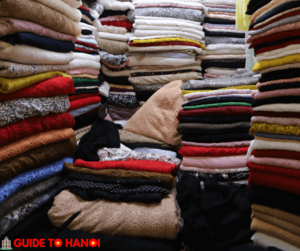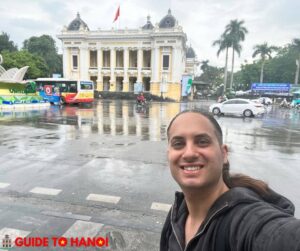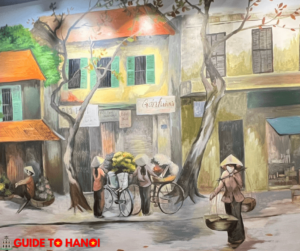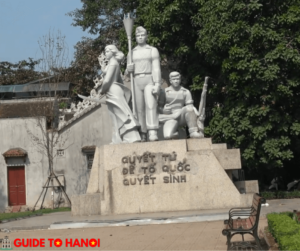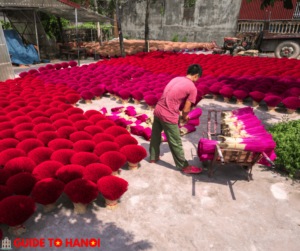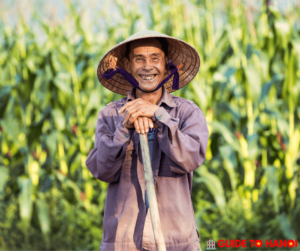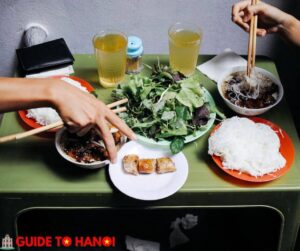To add in the future:
לשאול את הויאן מה אכלתי ומה חסר:
Banh Trang (mix, roll, grill)
Nem nuong nha trang
Banh day
–
אמרה לכתוב על Bún bò Huế
https://en.wikipedia.org/wiki/B%C3%BAn_b%C3%B2_Hu%E1%BA%BF
–
Bo Pia-
popular at west lake. you can add it behind Banh Tom.
Bánh tráng trộn
popular street food. i often eat it at 3 nguyen sieu. many people eat and take away, its a popular street food.
Nem Lui
nem nuong nha trang (almost the same as Nem Lui)
Welcome to the ultimate guide to the best street foods in Hanoi, where the bustling streets are filled with the enticing aromas of delicious Vietnamese cuisine.
From the iconic pho to lesser-known delicacies, Hanoi’s street food scene offers a culinary adventure.
Join us as we explore the vibrant flavors, vibrant culture, and vibrant personalities behind Hanoi’s most beloved street foods.
Get ready to tantalize your taste buds and discover the rich tapestry of flavors that make Hanoi a food lover’s paradise!
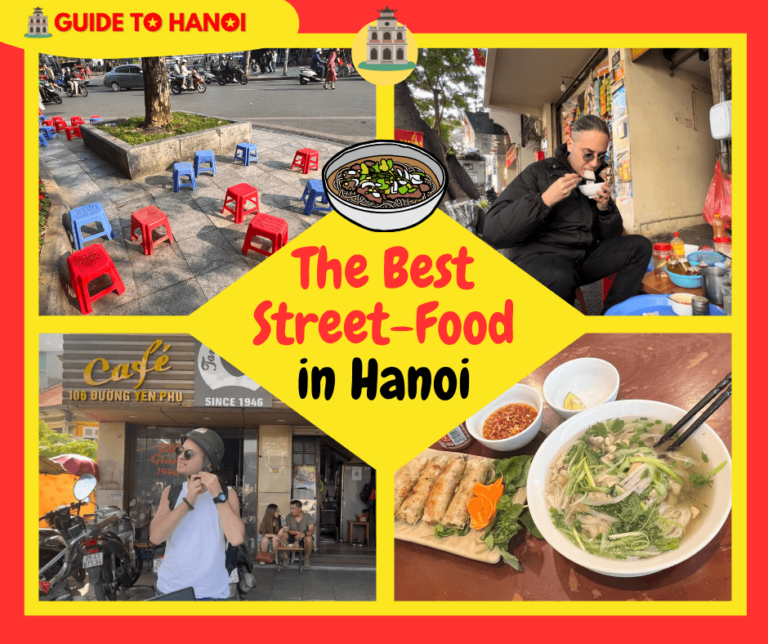
Pho
Imagine a steaming bowl of clear, aromatic broth filled with silky rice noodles, topped with slices of tender beef or chicken, and garnished with fresh herbs and a squeeze of lime.
Pho is not just a dish; it’s a national treasure, a culinary symphony that delights taste buds and warms the soul.
Whether slurping it up at a bustling street corner or savoring it in a cozy eatery, Pho is a must-try in Hanoi.
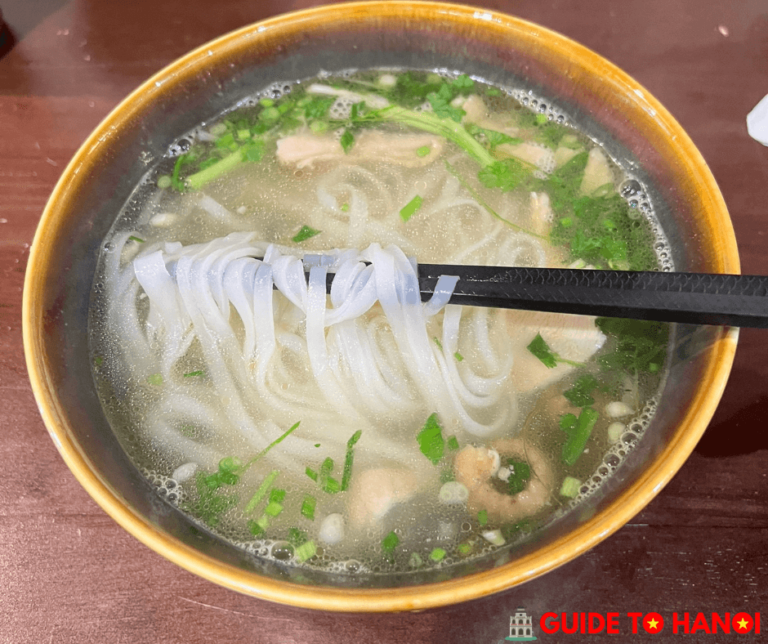
Bun Cha
Grilled pork nestled on a bed of vermicelli noodles, accompanied by a mountain of fresh herbs and a dipping sauce that packs a punch.
This dish is a harmonious blend of smoky, sweet, and savory flavors that dance on your palate with every bite.
It’s no wonder that even President Obama couldn’t resist its charms!
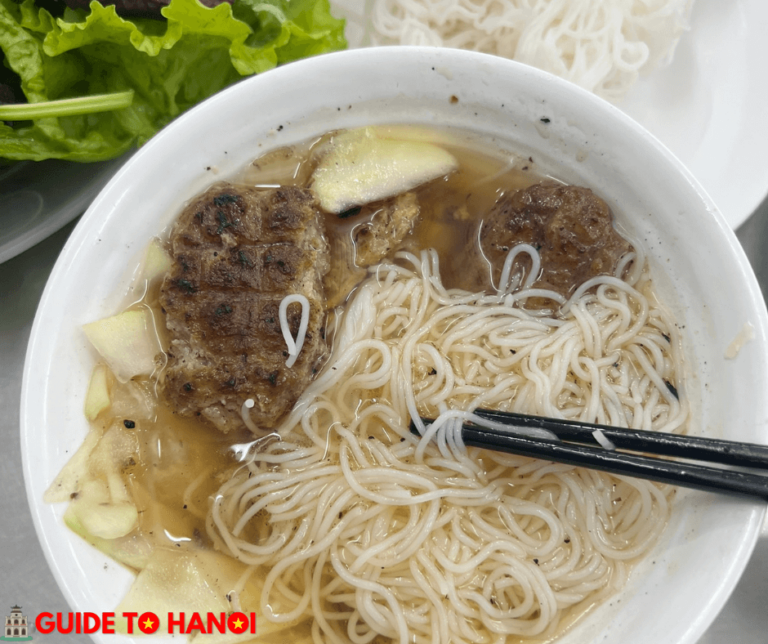
Banh Mi
Picture a crusty baguette filled with a symphony of flavors – pate, cold cuts, pickled carrots, cucumbers, cilantro, and chili sauce.
Banh Mi perfectly embodies Vietnam’s culinary fusion, a legacy of French colonial influence fused with local ingredients and flavors.
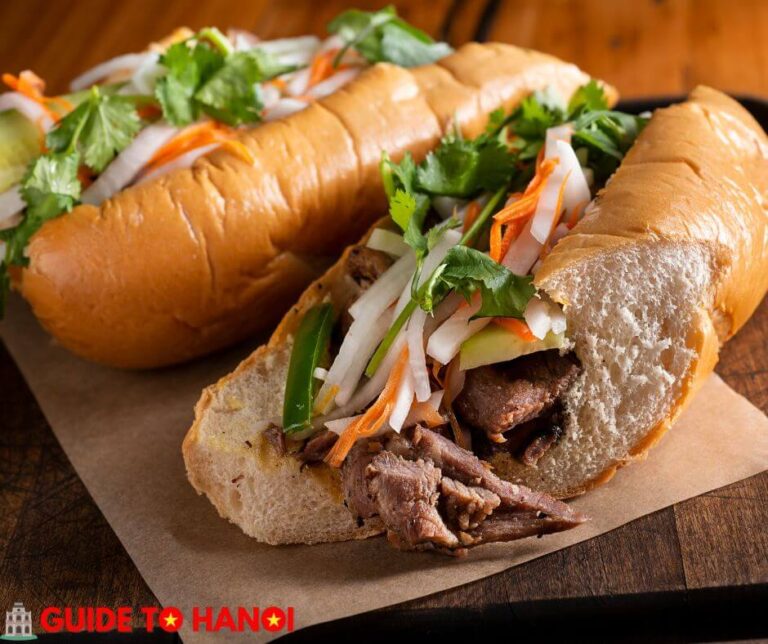
Cha Ca La Vong
Hanoi’s culinary gem, Cha Ca La Vong (Chả cá Lã Vọng), features marinated fish grilled to perfection, served with various accompaniments, including vermicelli noodles, peanuts, herbs, and shrimp paste.
It’s a dish that’s as much about the experience as it is about the flavors, with each element coming together to create a symphony of tastes and textures.
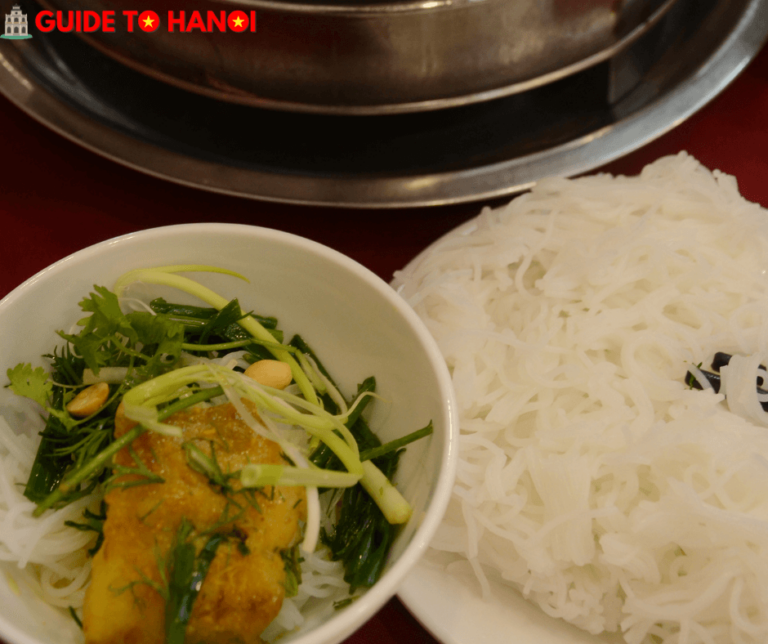
Ca Phe Trung (Egg Coffee)
Vietnamese egg coffee is a decadent treat with solid coffee, whipped egg yolks, sugar, and condensed milk.
It’s a rich, creamy, and indulgent drink, the perfect pick-me-up for a day of exploring the vibrant streets of Hanoi.
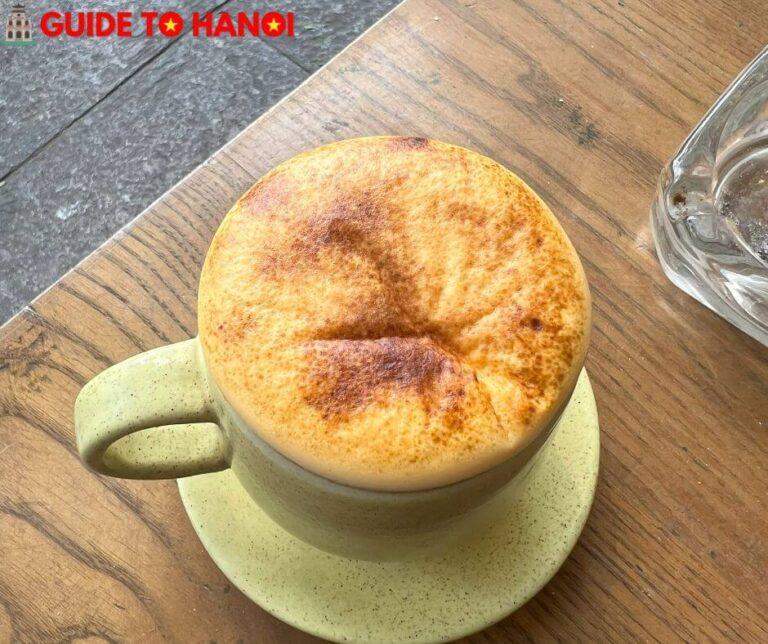
Hanoi Beer (Bia Hơi)
Ah, the elixir of Hanoi!
Bia Hoi is a light, refreshing draft beer brewed fresh daily and served in streetside stalls.
It’s the perfect accompaniment to a hot day or a spicy meal, and at just a few cents a glass, it’s a bargain you can’t pass up.
So grab a stool in Bia Hoi Corner (Beer Street), raise a glass with the locals, and cheer on the vibrant flavors of Hanoi!
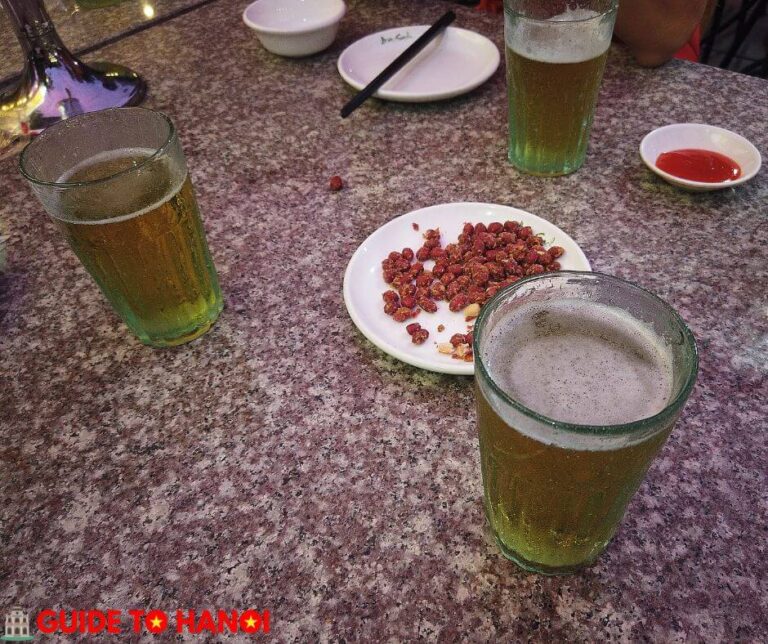
Banh Cuon
Delicate rice rolls filled with a savory mixture of minced pork and mushrooms, topped with fried shallots, and served with a dipping sauce.
Bánh Cuốn is a dish that’s as elegant as it is delicious, a testament to the skill and craftsmanship of Vietnamese cuisine.

Banh Goi
These delightful pillows of joy are Vietnamese fried dumplings, typically filled with minced pork, mushrooms, vermicelli noodles, and various spices.
Crispy on the outside and savory on the inside, they’re a perfect snack to munch on while exploring the bustling streets of Hanoi.

Bun Bo Nam Bo
A Bun Bo Nam Bo bowl is like a flavor explosion in your mouth!
This dish features tender slices of beef marinated in lemongrass and fish sauce, served over a bed of vermicelli noodles, fresh herbs, pickled vegetables, and crushed peanuts.
It’s a harmonious blend of sweet, savory, and tangy flavors that will leave you craving more.
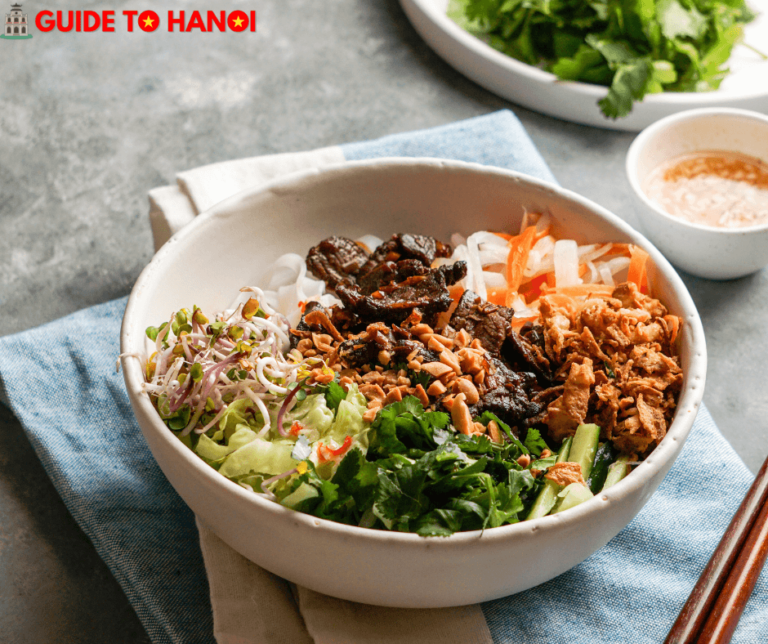
Cha Gio
Crispy fried spring rolls filled with a delectable mixture of pork, shrimp, mushrooms, and glass noodles, served with lettuce, herbs, and dipping sauce.
Cha Gio is a snack that’s crispy, savory, and utterly addictive, making it a favorite among locals and visitors alike.

Nem Cua Be
Imagine crispy, golden spring rolls filled with a savory mixture of crab, pork, mushrooms, and glass noodles.
Dip them in a tangy sauce and savor the explosion of flavors and textures with every bite.
Nem Cua Be is a snack that’s hard to resist and impossible to forget!

Bún Đậu Mắm Tôm (Noodles with Fried Tofu and Shrimp Paste)
Bún Đậu Mắm Tôm (Bun Dau Mam Tom) is a simple yet flavorful Northern Vietnamese dish.
It features small blocks of fried tofu, rice vermicelli noodles (bún), and fresh herbs, often served with a spicy shrimp paste dipping sauce (mắm tôm).
Cucumber slices, crispy pork belly, and sometimes chả cá (fried fish cake) are added to complete the dish.
The firm, salty flavor of the mắm tôm is balanced by the fresh herbs and the neutral taste of the tofu and noodles, offering an authentic taste of Vietnamese cuisine.
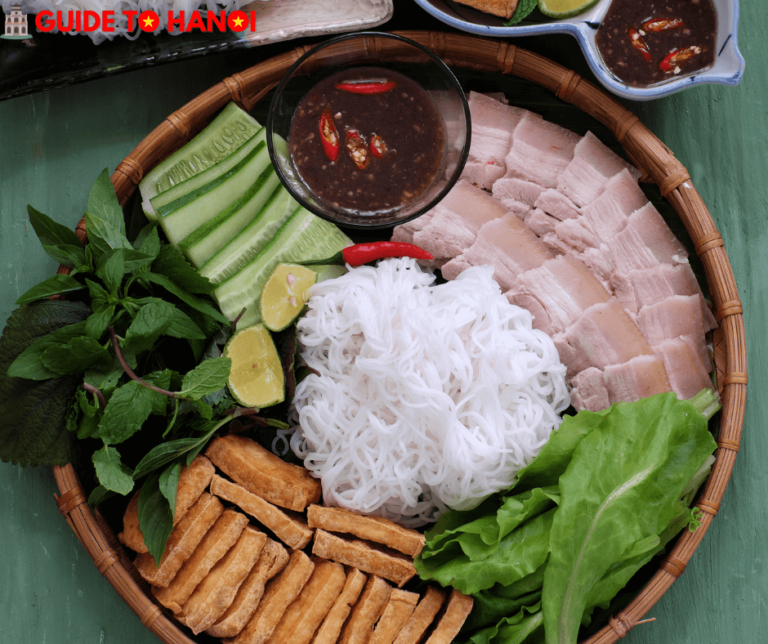
Xoi Xeo
Turmeric sticky rice infused with turmeric, topped with mung bean paste, fried onions, and your choice of toppings, such as shredded chicken or pork floss.
Xoi Xeo is a hearty and comforting dish perfect for any time of day, whether you’re looking for a quick snack or a filling meal.
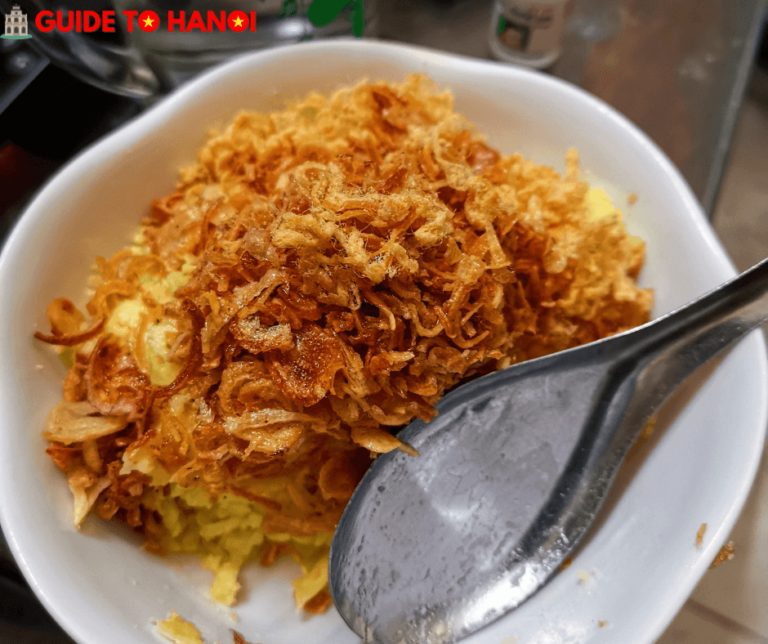
Banh Tom
Banh Tom, or Vietnamese shrimp fritters, are crispy, golden-brown treats that will tantalize your taste buds.
Made with sweet potato and whole shrimp dipped in a light batter and deep-fried to perfection, they’re crunchy on the outside and soft on the inside, making them a delightful snack or appetizer.

Lẩu (Vietnamese Hot Pot)
Lẩu, or Vietnamese hot pot, is a communal dining experience where friends and family gather around a simmering broth pot in the table’s center.
Ingredients vary but often include a selection of meats, seafood, tofu, vegetables, and noodles, which are cooked in the broth and eaten with dipping sauces.
The broth can range from light and fragrant chicken stock to rich and spicy broths infused with lemongrass, lime, and chili.
Lẩu is not just about the food; it’s a social event, a way to connect over the shared pleasure of cooking and eating.

Bánh Đa Trộn (Mixed Rice Noodles)
Bánh Đa Trộn (Banh Da Tron) is a delightful dish from Northern Vietnam, consisting of red rice noodles mixed with various ingredients such as grilled pork, fried onions, peanuts, and fresh herbs.
It’s dressed in a light sauce that typically includes fish sauce, lime juice, and sugar.
This dish is celebrated for its contrasting textures and flavors, combining the softness of the noodles with the crunch of peanuts and the savory taste of pork, all balanced with fresh herbs.
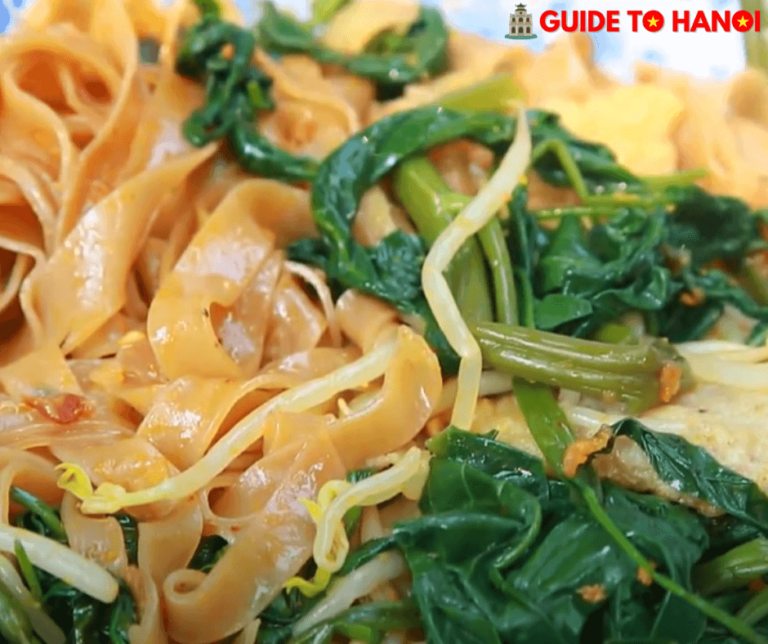
Chè (Vietnamese Sweet Dessert Soup)
Chè (Che) refers to Vietnamese sweet beverages, dessert soups, and puddings.
Ingredients include mung beans, black-eyed peas, kidney beans, tapioca, jelly (clear or grass), fruit (longan, mango, durian, lychee), and coconut cream.
Chè can be served hot or cold, and each variation has its unique taste and texture.
There are many kinds of Che, from mixed yogurt to black rice mixed with yogurt to jack fruit mixed with yogurt.
It’s a popular dessert or snack in Vietnam, showcasing the diverse use of local ingredients to create sweet treats.
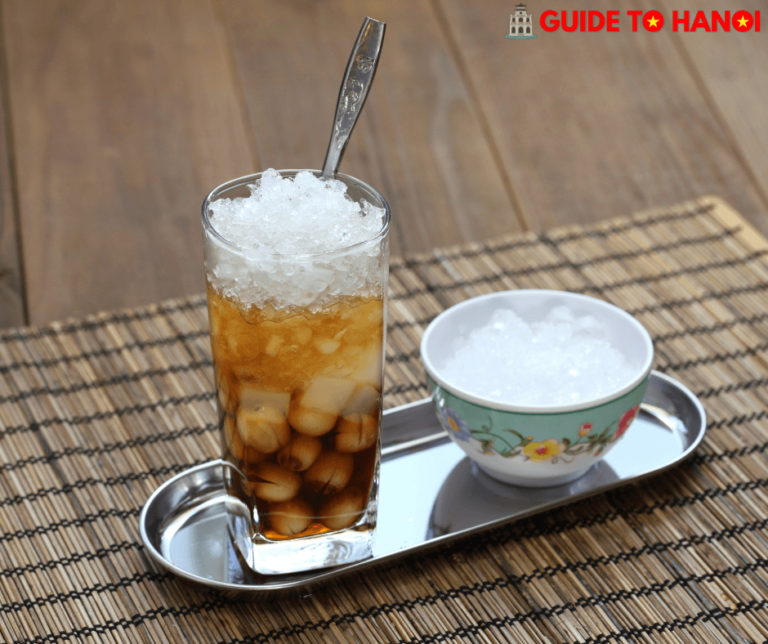
Gỏi Cuốn Tôm Thịt (Shrimp and Pork Spring Rolls)
Gỏi Cuốn Tôm Thịt (Goi Cuon Tom Thit), also known as Vietnamese spring rolls, are fresh, not fried, and packed with vermicelli noodles, shrimp, pork, and an assortment of herbs like basil and cilantro, all wrapped in rice paper.
They are served cold with a hoisin-based dipping sauce, often garnished with crushed peanuts.
These spring rolls perfectly represent Vietnamese cuisine, emphasizing freshness and lightness.
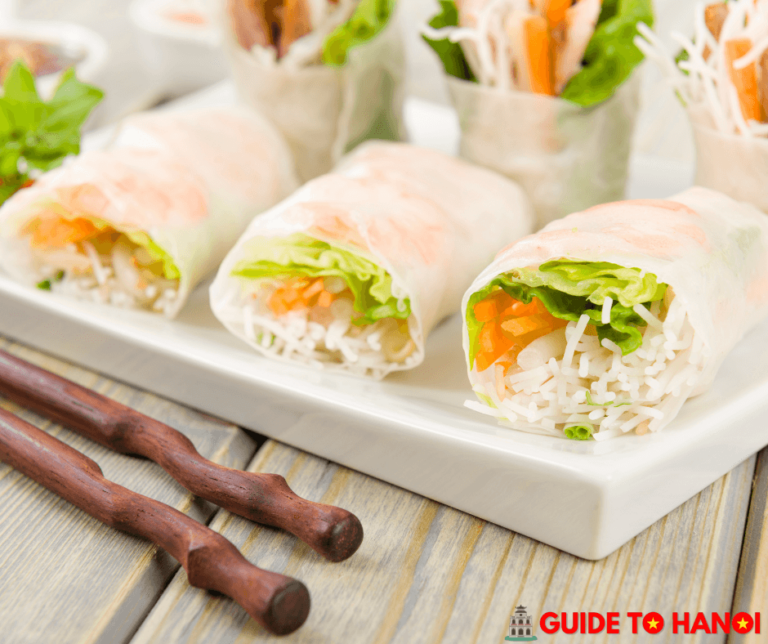
If you want to try eating snakes in Vietnam, there's one place to head – Le Mat Snake Village near Hanoi. The restaurants there specialize in serving snakes in an elaborate theatrical show.
Some believe Snake meat has medicinal properties and is often consumed for its supposed health benefits, such as improving vitality and circulation.
The snake is typically skinned, gutted, and then cooked in various ways, such as grilled, fried, or simmered in a soup.
While eating snakes is legal in Vietnam and is considered a delicacy by some, it is also a controversial practice that has sparked debates about animal welfare and conservation.
As a result, the consumption of snake meat is less common than it once was, particularly among younger generations and in urban areas.
Vietnamese Coconut Coffee (Cafe Cot Dua)
Vietnamese Coconut Coffee combines rich, strong coffee with sweet, creamy coconut milk, creating a deliciously indulgent drink. It can be served hot or cold, making it a versatile choice for coffee lovers.
The addition of coconut milk adds a tropical twist to the traditional Vietnamese coffee, making it a must-try for those looking to explore the country’s unique coffee culture.
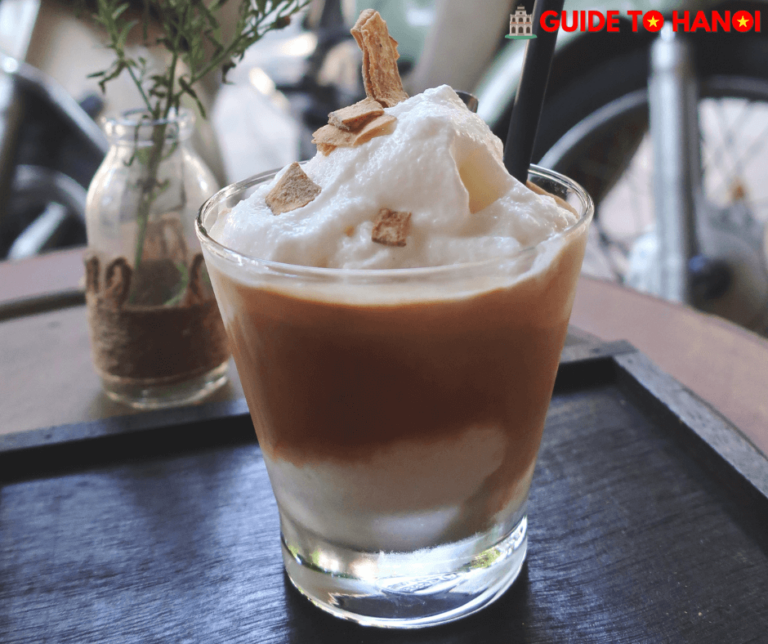
Bánh Tét (Vietnamese Rice Cake)
Bánh Tét (Banh Tet) is a traditional Vietnamese rice cake, similar to Bánh Chưng, consumed during the Lunar New Year (Tết Nguyên Đán).
It’s made from glutinous rice, mung bean paste, and pork belly, all wrapped in banana leaves and cooked by boiling. Unlike Bánh Chưng’s square shape, Bánh Tét is cylindrical.
The cake is sliced into circular servings, offering a sticky texture and a balanced taste of savory pork, creamy mung beans, and fragrant rice.
It symbolizes gratitude to ancestors and hope for a prosperous year ahead.

Bun Rieu Cua
This is not your average noodle soup!
Bun Rieu Cua features a flavorful broth made from crab paste, tomatoes, and pork, served with vermicelli noodles, crab meat, and tofu and topped with fresh herbs and a squeeze of lime.
It’s a hearty and satisfying dish that’s bursting with umami goodness.
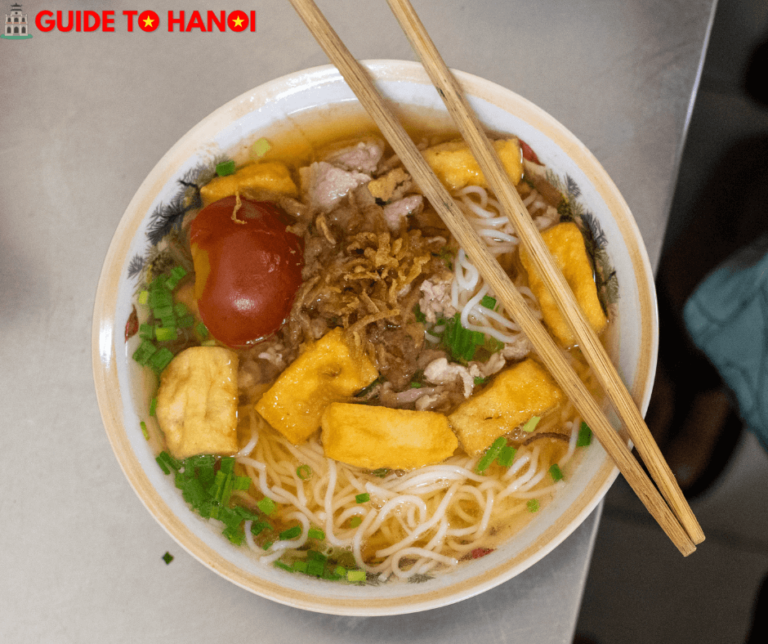
Bún Thang
This traditional noodle soup features delicate strands of vermicelli noodles, shredded chicken, thinly sliced pork, omelet strips, and a sprinkle of aromatic herbs, all swimming in a light, clear broth.
It’s a dish that’s as beautiful as it is delicious!
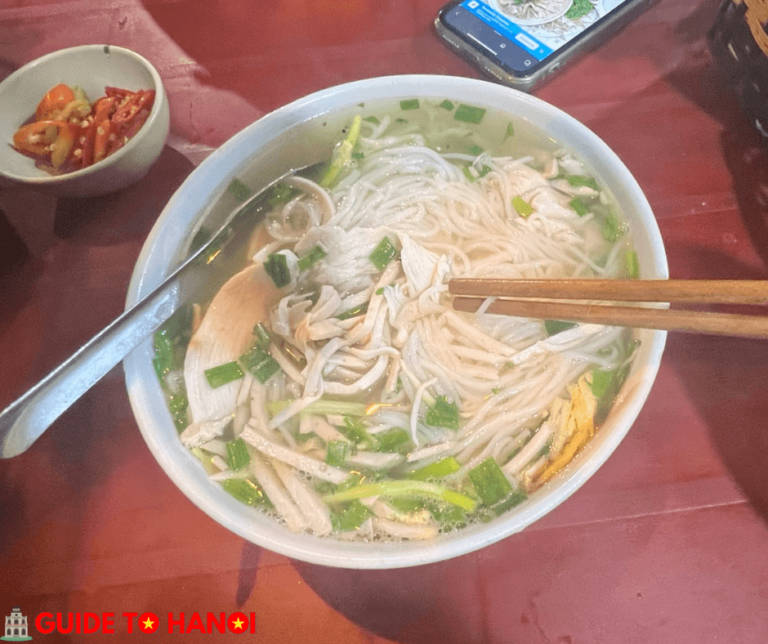
Bún Ốc
If you’re feeling adventurous, give Bún Ốc a try!
This noodle soup features snail meat cooked in a flavorful broth, served with vermicelli noodles, herbs, and a squeeze of lime.
It’s a unique and exotic dish that will tickle your taste buds.

Cốm Làng Vòng
Cốm Làng Vòng is a special treat that’s only available during the autumn season.
It’s young rice grains harvested early and roasted over a flame, giving them a distinctive green color and a nutty flavor.
Enjoy it alone or with a sweet treat for a truly Vietnamese experience.
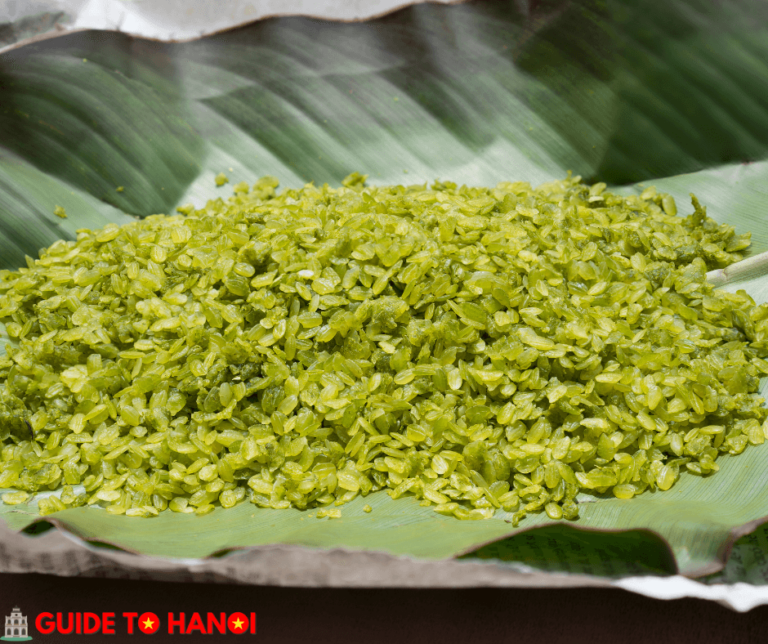
Bánh Tôm Hồ Tây
These crispy shrimp cakes are famous in Hanoi, especially around West Lake (Hồ Tây).
Made with whole shrimp coated in a light batter and deep-fried until golden brown, they’re crunchy on the outside and juicy on the inside, making them a favorite among locals and tourists alike.

Bánh Cốm
Bánh Cốm is a traditional Vietnamese treat made from young green rice mixed with sugar and coconut.
The mixture is then pressed into small molds to create bite-sized sweet, chewy, and flavorful cakes.
They’re a perfect snack for a cup of Vietnamese coffee or tea.
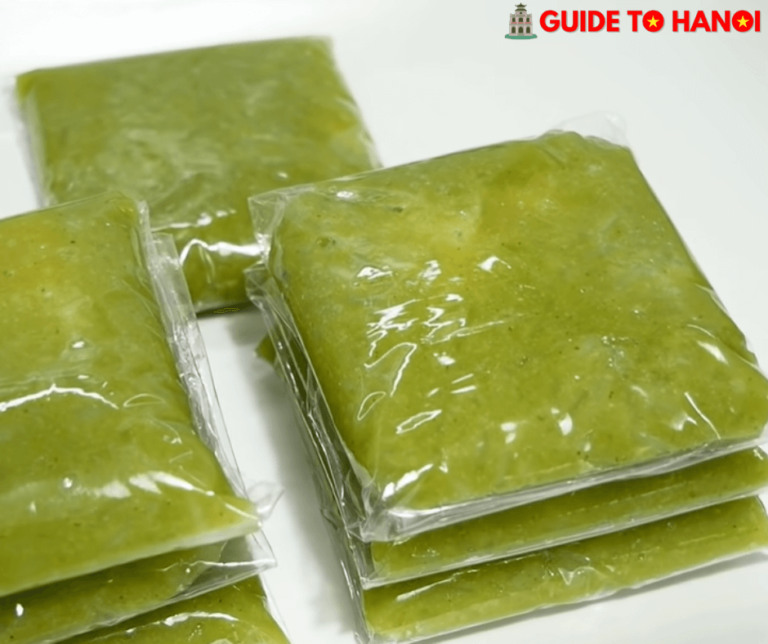
Bánh xèo
A popular Vietnamese dish is a crispy and savory fried pancake with various delicious ingredients.
The pancake’s batter is made from rice flour, coconut milk, and turmeric, giving it a distinct yellow color and a subtle fragrance.
Once cooked, the Banh Xeo is filled with shrimp, pork, bean sprouts, and mung beans, creating a flavorful and satisfying dish.
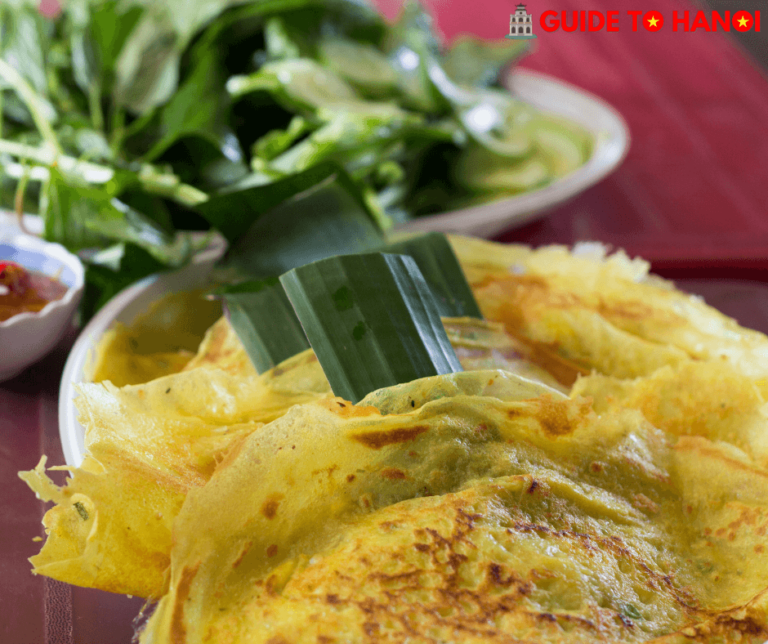
Bánh bao
Bánh Bao is a Vietnamese steamed bun filled with a savory mixture of ground pork, mushrooms, onions, and other ingredients.
The bun is made from a soft and fluffy dough, often colored white, while yellow is less common.
Bánh Bao is a popular snack or breakfast item in Vietnam.
It is enjoyed for its comforting flavors and satisfying texture.
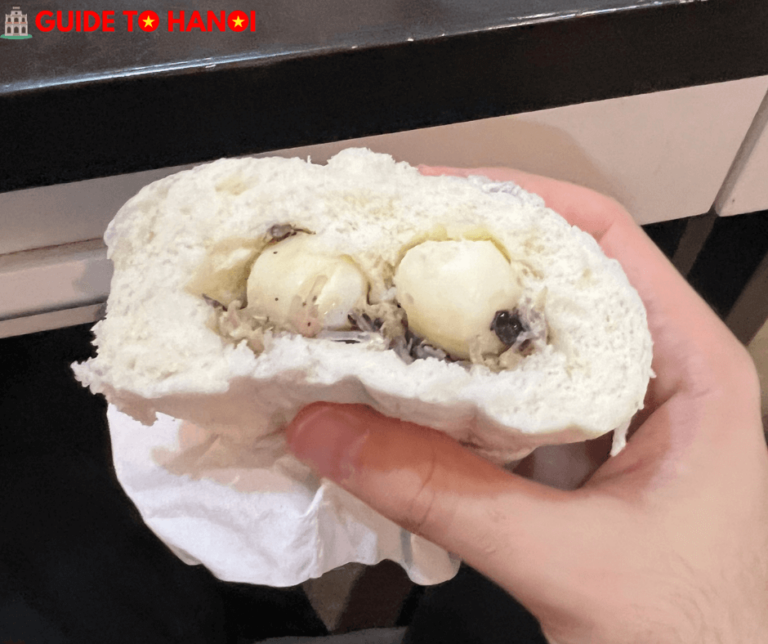
Banh Gai
Banh gai: a classic Vietnamese treat hailing from the Northern Delta, where the cakes are as square as a board meeting but way more fun.
Made from hemp leaves, they rock a deep, dark hue and pack a punch with the fragrant combo of green beans and sticky rice.
Down in Binh Dinh province, they’ve got their leafy delight: banh it gai gai leaves.
These bad boys are wrapped in fresh banana leaves and shaped like little pyramids, giving the original banh gai a run for its money!
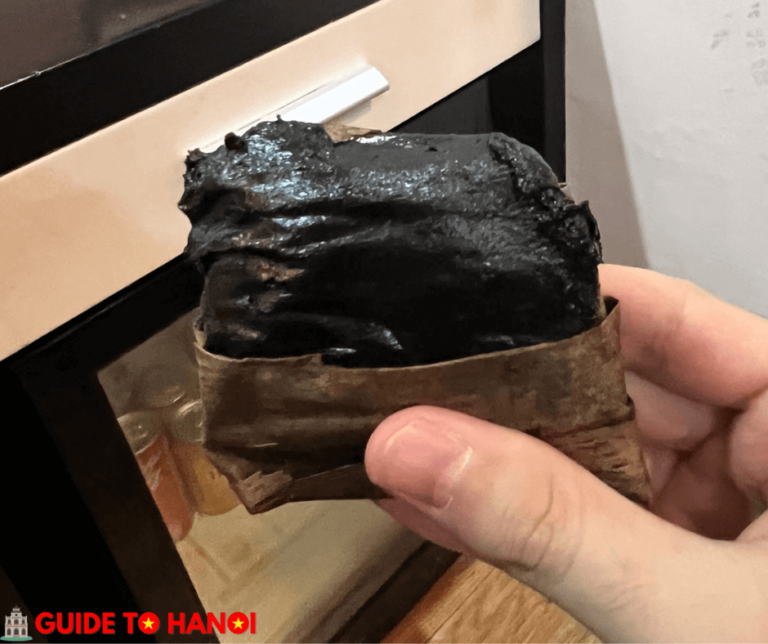
Bánh rán
Bánh Rán is a Vietnamese fried pastry made from glutinous rice flour filled with a sweet or savory filling.
The pastry is typically deep-fried until golden brown, giving it a crispy exterior and a soft, chewy interior.
Bánh Rán can be filled with various ingredients, such as mung bean paste, pork, or sweetened coconut, and is often coated in sesame seeds for added texture.
It is a popular street food snack in Vietnam, enjoyed for its contrasting flavors and textures.
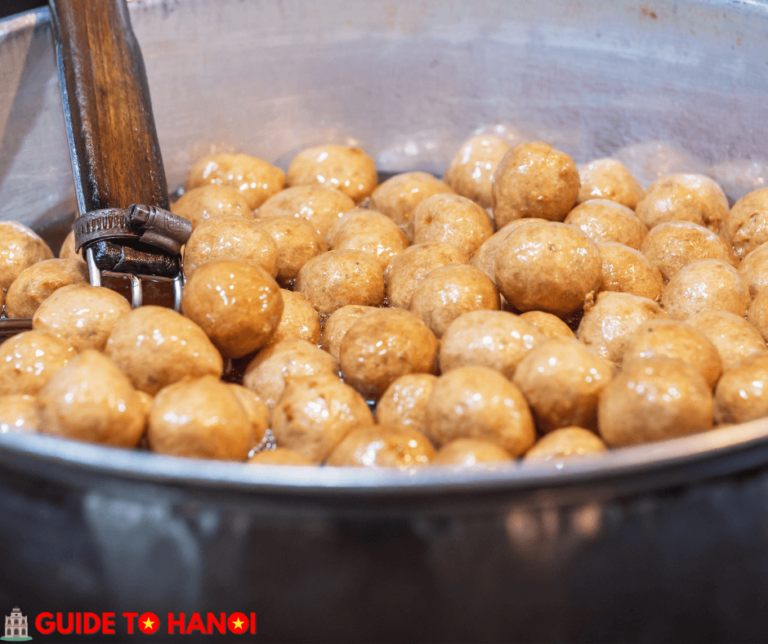
| Dish | Description |
|---|---|
| Pho | A famous Vietnamese noodle soup made with clear broth, rice noodles, herbs, and meat (usually beef or chicken). |
| Bun Cha | Grilled pork served with rice noodles, herbs, and a dipping sauce. |
| Banh Mi | A Vietnamese sandwich made with a crispy baguette filled with various ingredients such as pate, cold cuts, cucumber, pickled carrots, cilantro, and chili sauce. |
| Cha Ca La Vong | Grilled fish (usually catfish) marinated in turmeric, served with herbs, vermicelli noodles, peanuts, and shrimp paste. |
| Ca Phe Trung | Vietnamese egg coffee is a unique and indulgent drink made with solid coffee, whipped egg yolks, sugar, and condensed milk. |
| Bia Hoi | Freshly brewed draft beer, a popular drink in Hanoi. |
| Banh Cuon | Steamed rice rolls filled with minced pork and mushrooms, topped with fried shallots, and served with a dipping sauce. |
| Banh Goi | Fried pastry filled with minced pork, mushrooms, and glass noodles. |
| Bun Bo Nam Bo | Rice noodles topped with stir-fried beef, herbs, peanuts, and a sweet and sour dressing. |
| Cha Gio | Crispy fried spring rolls filled with minced pork, shrimp, mushrooms, and glass noodles, often served with lettuce, herbs, and dipping sauce. |
| Nem Cua Be | Deep-fried crab spring rolls, often enjoyed with a dipping sauce. |
| Xoi Xeo | Sticky rice cooked with turmeric and topped with mung bean paste, fried onions, and toppings such as shredded chicken, pork floss, or fried shallots. |
| Banh Tom | Deep-fried shrimp cakes are a popular snack in Hanoi. |
| Bun Rieu Cua | Crab noodle soup with a tomato-based broth is often served with tofu, pork, and shrimp. |
| Bun Thang | A delicate noodle soup with shredded chicken, pork, egg, and herbs. |
| Bun Oc | Snail noodle soup is a popular street food dish in Hanoi. |
| Com Lang Vong | Young rice flakes are a traditional delicacy of Hanoi. |
| Banh Tom Ho Tay | Sweet potato cakes are a specialty of Hanoi’s West Lake area. |
| Banh Com | Green rice flake cake, a traditional Vietnamese dessert made from young rice flakes. |
| Banh Xeo | Savory Vietnamese pancake made with rice flour, coconut milk, and turmeric, filled with shrimp, pork, and bean sprouts. |
| Lẩu | A communal hot pot with various meats, seafood, vegetables, and noodles cooked in a flavorful broth. |
| Bun Dau Mam Tom | A dish of rice vermicelli, fried tofu, and fresh herbs served with a spicy shrimp paste. |
| Bánh Đa Trộn | A mixed noodle salad with a base of bánh đa (rice crackers) is often topped with grilled meat, herbs, and a tangy dressing. |
| Gỏi Cuốn Tôm Thịt (Pho Spring Roll) | Fresh spring rolls filled with shrimp, pork, vermicelli noodles, and herbs, served with a hoisin-peanut dipping sauce. |
| Chè | Chè is a traditional Vietnamese sweet beverage, dessert soup, or pudding. |
| Vietnamese Coconut Coffee (Cafe Cot Dua) | A creamy and sweet coffee made with coconut milk, offering a tropical twist on traditional Vietnamese coffee. |
| Bánh Tét | A traditional Vietnamese rice cake made from glutinous rice, mung bean paste, and pork, all wrapped in a banana leaf and boiled. |
| Banh Bao | A Vietnamese steamed bun filled with a savory mixture of ground pork, mushrooms, and onions. |
| Banh Gai | Black sesame dumplings are made from glutinous rice flour, filled with black sesame paste and sugar, and rolled in dried, powdered seaweed. |
| Banh Ran | Vietnamese fried pastry is made from glutinous rice flour and often coated with sesame seeds. It is filled with a sweet or savory filling. |
Where can you get the best street food in Hanoi?
Hanoi is renowned for its incredible, vibrant street food scene, with numerous streets and alleys offering delicious and authentic Vietnamese cuisine.
Here’s a list of some of the best food streets in Hanoi:
Old Quarter (Hàng Buồm Street)
The Old Quarter is famous for its bustling atmosphere and diverse food options.
You can find everything from pho to banh mi and various local delicacies.
Tạ Hiện Street
Known as the “Beer Street,” Tạ Hiện is lined with small bars and eateries serving up local beers and tasty snacks, making it a popular spot in Hanoi for locals and tourists alike.
Lý Quốc Sư Street
This street is famous for its abundance of vegetarian food stalls and restaurants, offering flavorful dishes suitable for vegetarians and vegans.
Trấn Vũ Street
Located near West Lake, Trấn Vũ Street is renowned for its seafood restaurants, serving fresh and delicious seafood dishes at affordable prices.
Quán Thánh Street
Another street near West Lake, Quán Thánh is famous for its grilled dishes, including grilled meat, seafood, and vegetables, served with dipping sauces and fresh herbs.
Hàng Điếu Street
This street is known for its traditional Vietnamese desserts and sweets, including che (sweet soup), banh troi (glutinous rice balls), and banh ran (fried glutinous rice cakes).
Hàng Manh Street
If you’re craving bun cha (grilled pork with noodles) and nem cua be (crab spring rolls), Hàng Manh Street is the place to go. It’s a favorite among locals and visitors for its authentic flavors.
Hàng Bồ Street
Famous for its assortment of snacks and street food, Hàng Bồ Street offers a wide range of options, including nem chua (fermented pork rolls), banh gio (pyramid-shaped rice dumplings), and more.
Hoan Kiem Lake (Dinh Tien Hoang Street)
Surrounding the iconic Hoan Kiem Lake, Dinh Tien Hoang Street has food stalls and eateries offering a mix of traditional Vietnamese dishes and international cuisines.
Xóm Hương Street
In the heart of the Old Quarter, Xóm Hương Street is known for its traditional Vietnamese grilled dishes, including meat skewers, seafood, and vegetables.
These are just a few examples of the many food streets in Hanoi where you can indulge in delicious Vietnamese cuisine and experience the vibrant street food culture of the city.
While it has been a part of some Vietnamese culinary traditions for centuries, attitudes toward consuming dog meat are changing, particularly among younger generations and urban populations.
In Vietnam, dog meat is most commonly consumed in the northern regions and is often associated with specific traditional festivals or beliefs about its health benefits.
However, the practice has received criticism from animal rights groups, leading to debates about animal welfare and ethical considerations.
While eating dog meat is legal in Vietnam, there have been efforts to curb the practice, including campaigns to raise awareness about animal cruelty and to promote alternative sources of protein.
As a result, dog meat consumption in Vietnam is becoming less common, especially in urban areas.
What are 5 popular street foods in Vietnam?
Some famous street foods in Vietnam include Pho (noodle soup), Banh Mi (Vietnamese sandwich), Bun Cha (grilled pork with noodles), Cha Ca La Vong, and Banh ran.
Can you eat street food in Hanoi?
Yes, street food is a popular and integral part of Hanoi’s culinary culture.
Many locals and tourists enjoy eating street food in Hanoi.
Can you eat street food in Hanoi?
Yes, street food is a popular and integral part of Hanoi’s culinary culture.
Many locals and tourists enjoy eating street food in Hanoi.
What food is Hanoi famous for?
Hanoi is famous for its diverse street food scene, with dishes like pho, bun cha, banh mi, cha ca, and egg coffee among the most iconic and beloved choices.
How much does street food cost in Hanoi?
Street food in Hanoi is generally very affordable, with prices ranging from $1 to $4 per dish, depending on the type of food and the location.
Should you eat street food in Vietnam?
Many people enjoy street food in Vietnam without any issues.
However, it’s advisable to choose reputable vendors and eat freshly prepared food served hot to reduce the risk of foodborne illnesses.
How much does food cost per day in Hanoi?
On average, a budget traveler can expect to spend around $10 to $20 daily on food in Hanoi, including street food and meals at local eateries.
What time do people eat dinner in Hanoi?
In Hanoi, people typically eat dinner between 6:00 PM and 8:00 PM, although some restaurants and eateries may stay open later.
How much is a cup of coffee in Hanoi?
A cup of coffee in Hanoi can cost anywhere from $1 to $3, depending on the type of coffee and the cafe’s location.
How much is pho in Hanoi?
Pho prices in Hanoi can vary depending on the place, but a bowl of pho costs around $2 to $4 on average.
Is food better in Hanoi or Saigon?
Both Hanoi and Saigon (Ho Chi Minh City) have vibrant food scenes with their specialties.
It ultimately comes down to personal preference.
You sure know what I prefer… ah?
Do you tip at restaurants in Hanoi?
Tipping is not a common practice in Vietnam, including Hanoi.
However, if you receive exceptional service, a small tip is appreciated.
In conclusion
As you wrap up your culinary journey through the streets of Hanoi, it’s clear that this city is a haven for food enthusiasts.
From the savory broth of pho to the crispy delights of banh goi, each dish tells a story of tradition, innovation, and the vibrant spirit of the Vietnamese people.
Whether exploring the bustling alleys of the Old Quarter or savoring the flavors of a roadside stall, Hanoi’s street food scene offers an unforgettable experience for all who dare to indulge.
So, as you bid farewell to this gastronomic adventure, take with you the memories of these delectable dishes and the warmth of Hanoi’s hospitality.
Until next time, happy eating!



